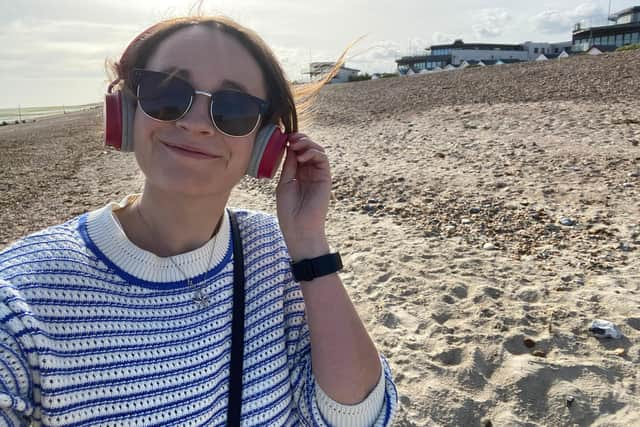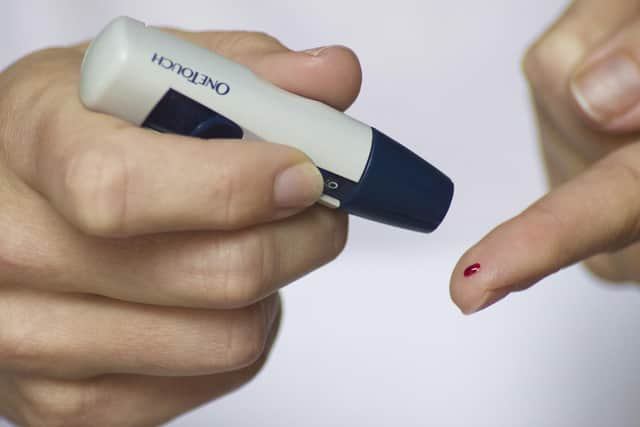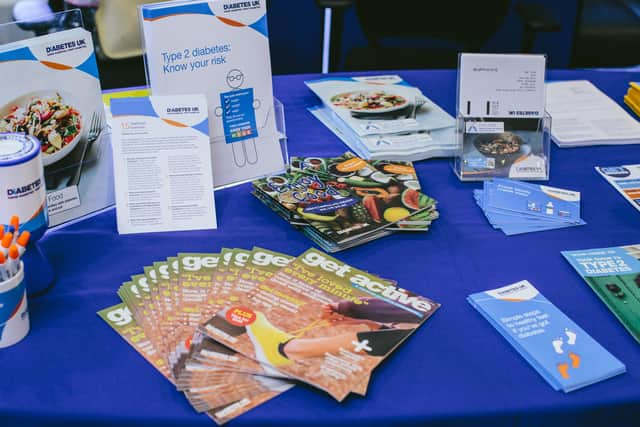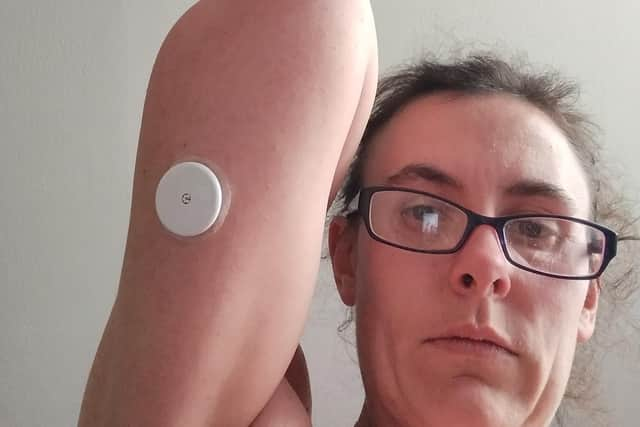Diabetes: What it is and what it is like to live with
and live on Freeview channel 276
Around 90 per cent of people with diabetes have type 2 with around eight per cent of people with type 1, and about two per cent of people with diabetes have rarer types.
The common symptoms of diabetes include going to the toilet a lot, especially at night, being really thirsty, feeling more tired than usual, losing weight without trying to, genital itching or thrush, cuts and wounds taking longer to heal, blurred eyesight and increased hunger.
Emily Davis lives in Worthing and has type 1.
Advertisement
Hide AdAdvertisement
Hide Ad

She controls her conditions with multiple daily injections, usually six or seven a day depending on what she has eaten.
Emily was diagnosed aged 16 when she had a week of unquenchable thirst and frequent urination.
She said: “I have to make sure I always carry a supply of sugar with me in case my sugar drops too low.
“Overall it’s manageable. It took me years to work out what works for me, how my body reacts to things, and I’m still learning. But I’ve never let my diabetes stop me from doing anything or eating anything I wanted.”
Advertisement
Hide AdAdvertisement
Hide Ad

Type 1 diabetes often arises in childhood, with an average age of diagnosis of 13 years.
Kellie Edwards’s son Taylor is 16 and is a type 1 diabetic.
In 2014 during a family day out in the summer holiday they found he needed to urinate and was drinking lots but had pale skin and dark eyes, Kellie called the doctor and they tested his bloods and they were off the chart and he was rushed to Alexander children’s hospital in Brighton.
Taylor said: “I felt that now I was different, I didn’t want to stand out, I wanted to be me and for diabetes to go away, I wanted to be fixed.”


Kellie, who lives in Brighton, added: “It’s such a shock when your child is diagnosed with a life long condition and knowing without insulin they would not survive.
Advertisement
Hide AdAdvertisement
Hide Ad“As a mum you want to protect you child. I can’t fix Taylor’s condition but I can fight it everyday with him, support him, and learn as much as I can because knowledge is key.
“Diabetes is scary, unfair, hard and difficult but as a family it will never beat us, we wake everyday and are grateful for what we have and everyday Taylor continues to be the brave warrior he is, he is never alone because I will always be beside him fighting each day with him.”
Taylor and his mum Kellie have raised thousands for Diabetes UK to raise awareness.


Sasha Gender lives in Angmering and was diagnosed with Type 1 diabetes in 2017 aged 23.
She had no medical history of diabetes in her family. She noticed something wasn’t right when she kept drinking a lot and going to the toilet a lot, this cycle continued for a couple of weeks but nothing would quench her thirst.
Despite eating more and more within six weeks Sasha lost three stone.
She said: “Four days later I lost another 9lbs and received a phone call from the diabetic team at the hospital to say I needed to get into hospital before I would go into a coma as I was diagnosed with type 1 diabetes. At that moment, my life changed. Everything, every thought, every plan requires diabetes at the forefront of my mind.”
Sasha is keen to educate other people on how different living with type 1 diabetes is.
“I help educate the younger ones to remove this misunderstanding of type 1 diabetes,” she said.


“Everything needs to be planned. It’s educating others of how they could save my life when blood sugars are too low. It’s knowing how to look after yourself when you are sick, there is more complications, more risks but that has never stopped me nor should it stop anyone with type 1 diabetes.”
“Type 1 diabetes can be very challenging but modern technology has come on leaps and bounds and will continue to do so: whilst it’s a difficult condition at times with the right support systems you can live a relatively normal life.”
Type 1 diabetes is a serious condition where your blood glucose (sugar) level is too high because your body can’t make a hormone called insulin. This happens because your body attacks the cells in your pancreas that make the insulin, meaning you can’t produce any at all. We all need insulin to live. It does an essential job. It allows the glucose in our blood to enter our cells and fuel our bodies.
Advertisement
Hide AdAdvertisement
Hide AdWhen you have type 1 diabetes, your body still breaks down the carbohydrate from food and drink and turns it into glucose. But when the glucose enters your bloodstream, there’s no insulin to allow it into your body’s cells. More and more glucose then builds up in your bloodstream, leading to high blood sugar levels.
There’s no known cure for type 1 diabetes right now.
Kim Wood, 32 from Hastings, was diagnosed with type 1 in March 2021.
She manages her diabetes with two types of insulin.
She said: “One is a 24 hour one which I take every morning which is called Tresiba and the other one Novorapid I have with meals, I also use this if my levels are high and need a little bit extra just to keep my sugar levels down. I also have a Libre sensor on the back of my arm which I scan with my phone to check my bloody sugars. This is a really good piece of technology as you don't have to prick your finger as much.”
Type 2 diabetes is a serious condition where the insulin your pancreas makes can’t work properly, or your pancreas can’t make enough insulin. This means your blood glucose (sugar) levels keep rising.
Advertisement
Hide AdAdvertisement
Hide AdHaving type 2 diabetes without treatment means that high sugar levels in your blood can seriously damage parts of your body, including your eyes, heart and feet. These are called the complications of diabetes. But with the right treatment and care, you can live well with type 2 diabetes and reduce your risk of developing them.
There isn't a permanent cure for type 2 yet. But strong evidence shows that some people can put their type 2 diabetes into remission by losing weight.
Remission in type 2 diabetes means your blood sugar levels are below the diabetes range, and you don't need to take diabetes medication.
Richard Starling was diagnosed with type 2 diabetes in 2018 during routine annual blood test.
He said: “Adopting a Low Carb diet is a lifestyle change that has benefits for diabetics. Under the medical supervision of my GP and with ongoing educational/support sessions on Zoom, I am back in control of my weight and health.
Advertisement
Hide AdAdvertisement
Hide Ad“Over 18 months, I have lost 24kg (and kept it off). I am now in T2 remission: my blood sugar levels are back in the normal range, and I no longer need the medication to control my diabetes. This improvement has also benefitted my general health; my fibromyalgia has no cure but it is much better managed. I am a bit more mobile although still have to pace my physical activity carefully.”
More people than ever are at risk of type 2 diabetes. If nothing changes, the charity predicts that 5.5 million people will have diabetes in the UK by 2030.
For more information on the charity, visit https://www.diabetes.org.uk/